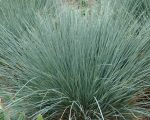 Blue oat grass is a clumping, cool season, evergreen ornamental grass, native to Eurasia where it grows in meadows and on dry hillsides. It is a member of the grass family, Poaceae, that also includes rice, corn, and bamboo. Plants g form a dense tuft 12-18″ tall of arching, metallic blue leaves with sharply pointed tips. In cold climates the plants may be semievergreen. In early to mid summer, spikelets of oat-like flowers appear in open panicles on arching stems 1-2″ above the foliage. The flowers are bluish white at first and dry to a golden wheat color. Plants resemble blue fescue (Festuca glauca) but are larger. Blue oast grass is valued primarily for its blue foliage and is attractive in borders or as a groundcover, as well as in Meditrranean, rock and coastal gardens. The genus name, Helictotrichon, comes from the Greek words helictos meaning twisted, and trichos meaning hair, and refers to the twisted base of the awns. The specific epithet, sempervirens, comes from the Latin words semper meaning always, and virens meaning green, and refers to its evergreen leaves.
Blue oat grass is a clumping, cool season, evergreen ornamental grass, native to Eurasia where it grows in meadows and on dry hillsides. It is a member of the grass family, Poaceae, that also includes rice, corn, and bamboo. Plants g form a dense tuft 12-18″ tall of arching, metallic blue leaves with sharply pointed tips. In cold climates the plants may be semievergreen. In early to mid summer, spikelets of oat-like flowers appear in open panicles on arching stems 1-2″ above the foliage. The flowers are bluish white at first and dry to a golden wheat color. Plants resemble blue fescue (Festuca glauca) but are larger. Blue oast grass is valued primarily for its blue foliage and is attractive in borders or as a groundcover, as well as in Meditrranean, rock and coastal gardens. The genus name, Helictotrichon, comes from the Greek words helictos meaning twisted, and trichos meaning hair, and refers to the twisted base of the awns. The specific epithet, sempervirens, comes from the Latin words semper meaning always, and virens meaning green, and refers to its evergreen leaves.
Type: Perennial grass
Bloom: Spiklets of oat-like flowers in open one sided panicles in early to mid summer
Size: 2-3′ H x 2-2.5′ W
Light: Full sun
Soil: Fertile, dry to mediummoist, well-drained
Hardiness: Zones 4-9
Care: Cut back foliage in late winter.
Pests and Diseases: Susceptible to rust and crown rot in warm humid climates, poorly drained soil, and/or shade.
Propagation: Seed, division in spring or fall
Companion Plants: Catnip (Nepeta spp), Siberian spurge, Sedum ‘Autum Joy’
Photo Credit:Wikipedia Commons